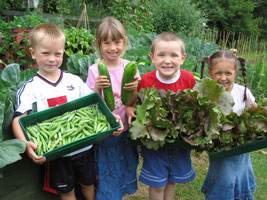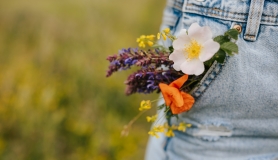What is a forest garden? A forest garden takes as its model the most wonderfully healthy and productive organic system in Britain – the deciduous woodland. It consists of trees and shrubs, with bushes below and a ground layer of perennial or selfseeding plants underneath. However, unlike a deciduous woodland, all plants in the forest garden are edible or useful in some other way. The first British forest garden was created by Robert Hart (1913 – 2000) at Wenlock Edge, Shropshire. Inspired by a need for more trees, as well as a need to produce healthy food, he envisaged a time in the future when thousands of forest gardens in towns and cities would together make up great urban forests. His own garden is a beautiful example of what can be achieved. On about an eighth of an acre, many different food-producing trees rise above masses of fruit bushes and herbs – over 70 species in all. These provided much of Robert’s food for over seven months of the year.
Advantages of forest gardening A forest garden offers a number of advantages over conventional gardening:
- It cuts down on labour, as the ground cover of plants means the garden does not demand constant digging, sowing, planting, hoeing, weeding, or watering. This makes it ideal for people who aren’t up to a lot of physical work, or for people who don’t have a lot of time to spend in the garden.
- It can be more productive than a single crop, because all the vertical space is used as short and tall plants, shallow-rooted and deeprooted plants grow side by side.
- It is suitable for difficult sites, such as steep slopes and areas with little soil, as the root systems of many perennial plants can penetrate rocky ground.
- It is more resistant to drought than a conventional garden, because mulches and groundcovers stop moisture from evaporating. Once it’s established, a forest garden should never need watering.
- It is more resistant to pests, because the high diversity of plants prevents the plagues that tend to build up on monocultures. Also, mature perennials can cope with attacks from slugs and other beasties that would wipe out rows of vegetable seedlings.
- Its no dig approach preserves the natural structure of the soil, so it stays fertile.
- It provides food and shelter for native animals (and humans enjoy it as well!).
“All plants in the forest garden are edible or useful in some other way.”
Designing the garden Remember that every forest garden is different. It can be any size, from a small backyard with one dwarf tree on upwards. Yours should be designed to suit the people who are going to use it: you, your family, school or community. You’ll need to consider how much time, energy, and resources you want to put into it, and what you want to get out of it. You may decide to include some open sunny patches for sitting, perhaps with a ground cover of lowgrowing herbs, a pond to attract more wildlife, or an abundance of colourful flowers to cut for the house. Once you’ve established the purposes of your forest garden, consider the space you’re going to use. Identify the plants already growing there, and decide whether they could become part of the forest garden. Find out if they are edible or have a high wildlife value. Observe the land over an entire year. Make sure you know the soil type and pH, drainage, local climate, micro climate, and aspect of the land before deciding on your plants. You will need to match your desires with the land’s own plant preferences – for example, if the soil is wet and acid, try to choose plants that thrive in wet and acid soil; if it’s in a cold hollow, choose cold-tolerant plants.
To continue reading this article and to find out how to select plants suitable for your garden, where to get free plants from, how to mulch and care for your forest garden, see issue 11 of The Green Parent magazine.







